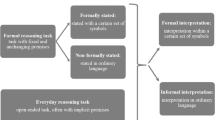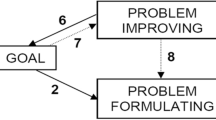Abstract
AI Planning & Scheduling techniques are being widely used to adapt learning paths to the special features and needs of students both in distance learning and lifelong learning environments. However, instructors strongly rely on Planning & Scheduling experts to encode and review the domains for the planner/scheduler to work. This paper presents an approach to automatically extract a fully operational HTN planning domain and problem from a learning objects repository without requiring the intervention of any planning expert, and thus enabling an easier adoption of this technology in practice. The results of a real experiment with a small group of students within an e-Learning private company in Spain are also shown.
Similar content being viewed by others
References
Alguacil-Martin, S. (2008). Tailored learning experiences. Andalusian Regional Government Research Portal. www.andaluciainvestiga.com/espanol/noticias/9/6915.asp.
Allen, J. (1983). Maintaining knowledge about temporal intervals. Communications of ACM, 26(1), 832–843.
ANSI/IEEE (2007). IEEE Standard for Learning Object Metadata. http://ltsc.ieee.org/wg12/.
Bienkowski, M. (1995). Demonstrating the operational feasibility of new technologies: The ARPI IFDs. IEEE Expert, 10(1), 27–33.
Boticario, J., & Santos, O. (2007). A dynamic assistance approach to support the development and modelling of adaptive learning scenarios based on educational standards. In Fifth international workshop on authoring of adaptive and adaptable hypermedia. International conference on user modelling.
Castillo, L., Fdez-Olivares, J., García-Pérez, O., & Palao, F. (2006). Efficiently handling temporal knowledge in an HTN planner. In Sixteenth international conference on automated planning and scheduling, ICAPS.
Cole, J., & Foster, H. (2007). Using moodle. Sebastopol: O’Reilly.
Dechter, R., Meiri, I., & Pearl, J. (1991). Temporal constraint networks. Artificial Intelligence, 49, 61–95.
Edelkamp, S., & Hoffmann, J. (2004). The language for the 2004 international planning competition. http://ls5-www.cs.uni-dortmund.de/~edelkamp/ipc-4/pddl.html.
Fdez-Olivares, J., Castillo, L., García-Pérez, O., & Palao, F. (2006). Bringing users and planning technology together. Experiences in SIADEX. In Sixteenth international conference on automated planning and scheduling, ICAPS. Awarded as the Best Application Paper of this edition.
Figueroa-Martínez, J., Morales, L., & Castillo, L. (2008). Extending moodle SCORM module to support basic ims-ld. In MoodleMoot, Spain, 2008.
Garrido, A., Onaindía, E., & Sapena, O. (2008). Planning and scheduling in an e-learning environment. A constraint-programming-based approach. Engineering Applications of Artificial Intelligence, 21(5), 733–743.
Ghallab, M., Nau, D., & Traverso, P. (2004). Automated planning: theory and practice. San Mateo: Morgan Kaufmann.
Goldman, R. (2006). Durative planning in HTNs. In Proceedings of ICAPS.
González-Ferrer, A., Castillo, L., Fdez-Olivares, J., & Morales, L. (2008). Towards the use of xpdl as planning and scheduling modeling tool: the workflow patterns approach. In Advances in artificial intelligence (IBERAMIA 2008). Berlin: Springer.
Ilias, L. M. S. (2007). ILIAS website. http://www.ilias.de/ios/index-e.html.
IMS-GLC (2007). IMS Global Learning Consortium. http://www.imsglobal.org/.
Koper, R. (2005). An introduction to learning design. In R. Koper & C. Tattersall (Eds.), Learning design: a handbook on modelling and delivering networked education and training (pp. 3–20). Berlin: Springer.
Kuter, U., Nau, D., Reisner, E., & Goldman, R. (2007). Conditionalization: adapting forward-chaining planners to partially observable environments. In ICAPS 2007—workshop on planning and execution for real-world systems.
Long, D., & Fox, M. (2003). PDDL2.1: an extension to PDDL for expressing temporal planning domains. Journal of Artificial Intelligence Research, 20, 61–124.
Luckin, R., Underwood, J., du Boulay, B., Holmberg, J., Kerawalla, L., O’Connor, J., Smith, H., & Tunley, H. (2006). Designing educational systems fit for use: a case study in the application of human centred design for AIED. International Journal of Artificial Intelligence in Education, 16, 353–380.
Morales, L., Castillo, L., Fernández-Olivares, J., & González-Ferrer, A. (2008). Building learning designs by using an automatic planning domain generation: A state-based approach. In European starting AI researcher symposium, STAIRS08.
Muscettola, N., Nayak, P. P., Pell, B., & Williams, B. C. (1998). Remote agent: to boldly go where no AI systems has gone before. Artificial Intelligence, 5–48.
Myers, K. L. (1999). CPEF: A continuous planning and execution framework. AI Magazine, 20(4), 63–69.
Nau, D., Au, T., Ilghami, O., Kuter, U., Murdock, J. W., Wu, D., & Yaman, F. (2003). SHOP2: An HTN planning system. Journal of Artificial Intelligence Research, 20, 379–404.
Petrick, R., & Bacchus, F. (2004). Extending the knowledge-based approach to planning with incomplete information and sensing. In Proceedings of the international conference on automated planning and scheduling (pp. 2–11).
R-Moreno, M., & Camacho, D. (2006). AI techniques for automatic learning design. In International electronic conference on computer science (IeCCS-2006).
Sicilia, M. A., Sánchez-Alonso, S., & García-Barriocanal, E. (2006). On supporting the process of learning design through planners. In F. J. García et al. (Eds.), Virtual campus 2006 selected and extended papers (pp. 81–89).
Toro, S. T., Castillo, L., Morales, L., Jiménez-Galera, M., Llorca-Díez, M., & Carrillo, J. O. (2008). Customizing learning routes in moodle based on Honey–Alonso learning styles. In MoodleMoot, Spain, 2008.
Ullrich, C. (2005). Course generation based on HTN planning. In Proceedings of 13th annual workshop of the SIG adaptivity and user modeling in interactive systems (pp. 74–79).
Wilkins, D. E., & des Jardins, M. (2001). A call for knowledge-based planning. AI Magazine, 22(1), 99–115.
Wilkins, D. E., & Desimone, R. V. (1994). Applying an AI planner to military operations planning. In M. Zweben & M. S. Fox (Eds.), Intelligent scheduling. San Mateo: Morgan Kaufmann.
Author information
Authors and Affiliations
Corresponding author
Rights and permissions
About this article
Cite this article
Castillo, L., Morales, L., González-Ferrer, A. et al. Automatic generation of temporal planning domains for e-learning problems. J Sched 13, 347–362 (2010). https://doi.org/10.1007/s10951-009-0140-x
Published:
Issue Date:
DOI: https://doi.org/10.1007/s10951-009-0140-x




